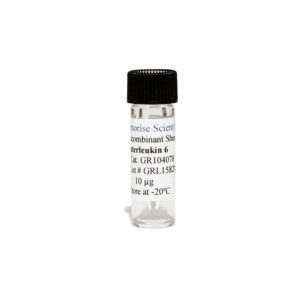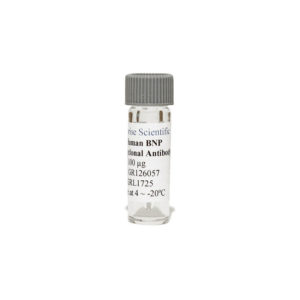Recombinant Rabbit Osteopontin Protein
$99.00 – $456.00
The recombinant rabbit OPN protein is derived from in vivo expression of rabbit SPP1 gene in E. coli and purified using his-tag affinity column and can be used in multiple applications such as cell culture, ELISA and western blot.
Alternative names for osteopontin: OPN. SPP1, secreted phosphoprotein 1, bone sialoprotein I, BSP-1, BNSP, early T-lymphocyte activation, ETA-1, secreted phosphoprotein 1, SPP1, 2ar and Rickettsia resistance, Ric
This product is for Laboratory Research Use Only not for diagnostic and therapeutic purposes or any other purposes.
- Description
- Product Citations
- Reviews (0)
Description
Genorise Recombinant Rabbit Osteopontin Protein Summary
Alternative names for osteopontin: OPN. SPP1, secreted phosphoprotein 1, bone sialoprotein I, BSP-1, BNSP, early T-lymphocyte activation, ETA-1, secreted phosphoprotein 1, SPP1, 2ar and Rickettsia resistance, Ric
Product Specifications
| Purity | > 97%, by SDSPAGE under reducing conditions and visualized by silver stain. |
| Endotoxin Level | < 0.1 EU per 1 μg of the protein by the LAL method. |
| Activity | Measured in a cell proliferation assay using TF-1 human erythroleukemic cells. |
| Source | E. coli derived rabbit OPN. |
| Accession # | E5KXC5 |
| N-Terminal Sequence Analysis | Leu |
| Amino Acid Sequence | Leu17-Asn314 |
| Predicted Molecular Mass | 33 kDa |
| SDS-PAGE | 33 kDa, reducing conditions |
Background:
Osteopontin (OPN), also known as bone sialoprotein I (BSP-1 or BNSP), early T-lymphocyte activation (ETA-1), secreted phosphoprotein 1 (SPP1), 2ar and Rickettsia resistance (Ric),[1] is a protein that is encoded by the SPP1 gene (secreted phosphoprotein 1). The murine ortholog is Spp1. Osteopontin is a SIBLING (glycoprotein) that was first identified in 1986 in osteoblasts. It is expressed in bone, but also in other tissues such as monocytes and macrophages.[2] Like its name, osteopontin functions as a linking protein and is involved in various cellular processes such as cell activation and apoptosis and various diseases such as cancer, heart disease and inflammatory diseases. Osteopontin is an extracellular structural protein and therefore an organic component of bone. Synonyms for this protein include sialoprotein I and 44K BPP (bone phosphoprotein). Full-length OPN (OPN-FL) can be modified by thrombin cleavage, which exposes a cryptic sequence, SVVYGLR on the cleaved form of the protein known as OPN-R. This thrombin-cleaved OPN (OPN-R) exposes an epitope for integrin receptors of α4β1, α9β1, and α9β4.[3] OPN-R can be further cleaved by Carboxypeptidase B (CPB) by removal of C-terminal arginine and become OPN-L. It appears an intracellular variant of OPN (iOPN) is involved in a number of cellular processes including migration, fusion and motility.[4] Various human cancers, including breast cancer, have been observed to express splice variants of OPN.[5] The cancer-specific splice variants are osteopontin-a, osteopontin-b, and osteopontin-c. Exon 5 is lacking from osteopontin-b, whereas osteopontin-c lacks exon 4.[5] Osteopontin-c has been suggested to facilitate the anchorage-independent phenotype of some human breast cancer cells due to its inability to associate with the extracellular matrix.[5]
References
- Rangaswami H, et al. (2006). Trends Cell Biol. 16 (2): 79–87.
- Sodek J, et al. (2006). Dent. Res. 85 (5): 404–15.
- Laffón A, et al. (1991). Clin. Invest. 88 (2): 546–52.
- Zohar R, et al. (2000). J Cell Physiol 184 (1): 118–130.
- He B, et al. (2006). Oncogene 25 (1): 2192–2202.
Product Citations
Be the first to review “Recombinant Rabbit Osteopontin Protein”
You must be logged in to post a review.



























Reviews
There are no reviews yet.